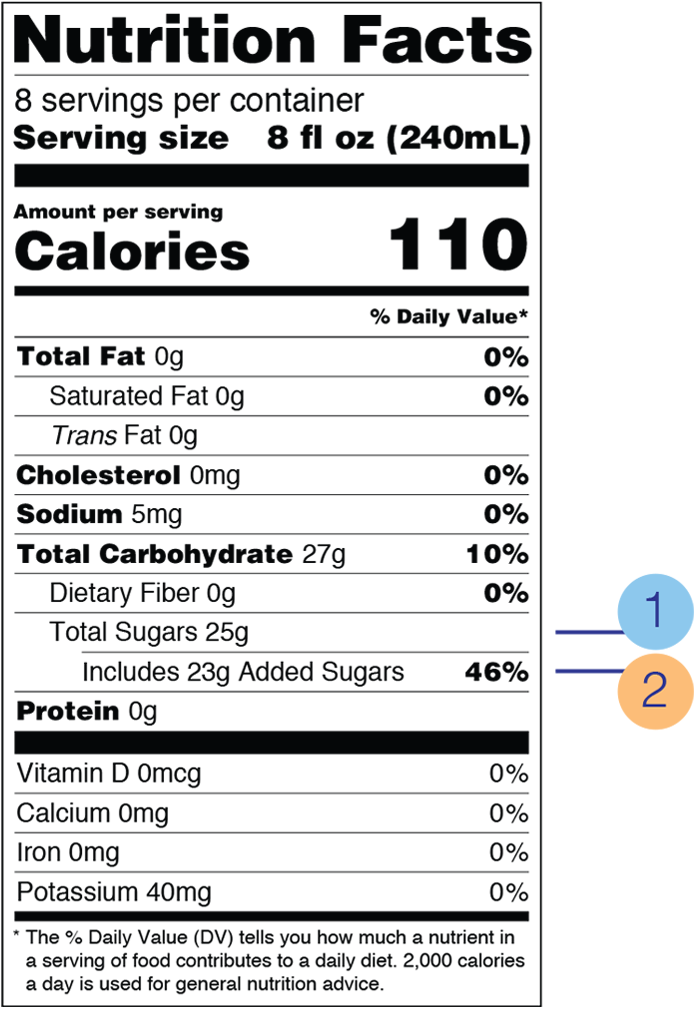
The Nutrition Facts label on packaged foods and drinks makes it easier for you to make informed choices.
Read on to learn more about Added Sugars.

Total Sugars include sugars naturally present in many nutritious foods and beverages, such as sugar in milk and fruits as well as any added sugars that may be present in the product. There is no Daily Value* for total sugars because no recommendation has been made for the total amount to eat in a day.
Added sugars include sugars that are added during the processing of foods (such as sucrose or dextrose), foods packaged as sweeteners (such as table sugar), sugars from syrups and honey, and sugars from concentrated fruit or vegetable juices. They do not include naturally occurring sugars that are found in milk, fruits, and vegetables. The Daily Value for added sugars is 50 grams per day based on a 2,000 calorie daily diet.
For most Americans, the main sources of added sugars are sugar-sweetened beverages, baked goods, desserts, and sweets.

*The Daily Values are reference amounts (in grams, milligrams, or micrograms) of nutrients to consume or not to exceed each day.
The Dietary Guidelines for Americans recommends limiting calories from added sugars to less than 10 percent of total calories per day. For example, if you consume a 2,000 calorie daily diet, that would be 200 calories or 50 grams of added sugars per day. Consuming too much added sugars can make it difficult to meet nutrient needs while staying within calorie limits. Added sugars are listed on the Nutrition Facts label so that you can make informed choices, based on your individual needs and preferences.
Labels for foods and beverages with added sugars list the number of grams and the percent Daily Value (%DV) for added sugars within the Nutrition Facts label.
Having the word “includes” before added sugars on the label indicates that added sugars are included in the number of grams of total sugars in the product.
For example, a container of yogurt with added sweeteners, might list:

This means one serving of the product has 7 grams of added sugars and 8 grams of naturally occurring sugars – for a total of 15 grams of sugar. The 7g of added sugars represents 14% of the Daily Value for added sugars.
Labels on packages and containers of single-ingredient sugars and syrups such as table sugar, maple syrup, or honey list the percent Daily Value for added sugars within the Nutrition Facts label, and the gram amount per serving and %DV may be included in a footnote. Single-ingredient sugars and syrups are labeled in this way so that it does not look like more sugars have been added to the product and to ensure that consumers have information about how a serving of these products contributes to the Daily Value for added sugars and to their total diet.
Single-Ingredient Sugars and Syrups Sample Label

The Nutrition Facts label can help you compare and choose foods that are lower in added sugars.
Check the label to see if foods are LOW or HIGH in added sugars.
The Dietary Guidelines for Americans states that a limited amount of added sugars can be included as part of an overall healthy eating pattern that includes healthy choices from each of the MyPlate food groups (vegetables, fruits, grains, dairy, and protein foods). It is important to remember that added sugars is just one piece of information on the label. Looking at the ingredient list and reading all the information on the Nutrition Facts label can help you make the most informed choices.
Learn More: